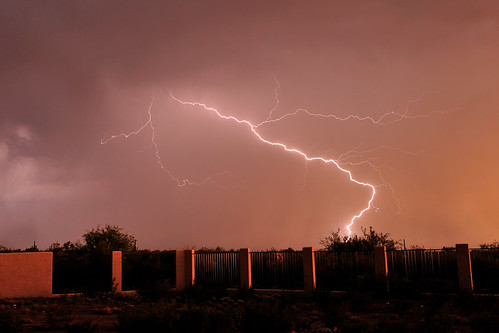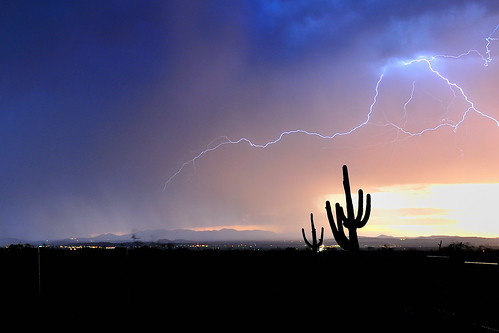
This is only the second time I've tried to capture lighting strikes. Last year I tried it on my D40 and a 50mm. I didn't really think much of it and just experimented. Got some OK shots, but no big deal. With all the books and reading I've been doing for the past 7 months about strobes and off camera flash, from studio portraits to outdoor fun...etc., I figure I share a bit of the concept of capturing lighting strikes in terms of the "light".
Think of lighting strikes as a big giant strobe. When it goes off, it's not much different than if you had a big strobe down the street flashing at you. Now, go back and think about what I wrote in my previous blog on the effects of flash and ambient light, and how to work with both to get what you want. If you recall, I said the shutter speed basically have no affect on the light from the flash. This is similar in concept for simple captures of lighting strikes. Why? I mean, you can see the lighting strike lasting a lot longer then your flash or strobe, so I understand the idea of when a flash goes off for only 1/8000s and thus the shutter has no affect...but...
:) without getting too technical, here's why. The distance of the lighting strike from your camera, the short duration and the ambient light. For most of us, we are not going to have a light detecting camera shutter trigger to time the lighting strike just as it happens. If you had, you can set the exposure to just expose for the light from the bolt. But, even then, if it's darkish, you can have the shutter open for much longer than the lighting strike (see the test below with the flash) duration since the light will quickly dissipate and not cause an over exposure.
For those of us without the light detecting trigger, this is what you do. First, you want to set the camera on a tripod. Now, set the shutter to 8 to 13 seconds. Yes, seconds. Depending on the ambient, you can increase or shorten the shutter speed. Set the ISO to 400. Now set the aperture to f/8 and just start shooting. I'm sure you will get lucky and capture a few strikes.
Why does the above work? Let's break this down a bit...
1) shutter speed. Most of the time, you will be shooting at night, so you can have a long shutter speed, which will let in more light. This helps with getting ambient light for the exposure. Because the lighting strike is quick, it does not matter much having the shutter opened for so long.
Think of the light from a strike (or your flash) as a cup of water. A big thick towel on the floor as the camera sensor. If I pour the cup of water on the towel, it will get wet, but it will only get as wet as a cup of water, 8 oz, that's it! No more, no less. Now, think of the same thing again and this time, it's outside and drilling rain. A very light drizzle. If you leave the towel out for 10 seconds, it will start to get wet, but how wet depends on how heavy the drizzle. So, now picture the drizzle as ambient light...if it's not very bright, it's like a very light drizzle. To get more light (or the towel more wet) on to the sensor, you need to leave the shutter open longer (leave the towel out longer). Back to the towel...light drizzle, put the towel out, after 2 seconds, barely moist...now dump the cup of water on the towel...splash! You just got the towel wet by an amount of 8 oz of water...this is like the light flashing to the camera sensor.
Even after you dump the cup of water on the towel, it is only going to get more wet from the light drizzle, which is not much...even if you leave it out for another 5 seconds longer, it's not going to get much more wet than what the cup of water had already done...get the point? This is why shutter speed does not affect short burst of light, like a flash.
2) Aperture. This actually has a major impact on the light from the strike. It will also have some affect on the ambient, but with a long shutter speed, the affect can be minimal. Depending on how close and how big/bright the strike is, you will need to fine tune the aperture a bit. If you have a big storm close to you and some spectacular big long strikes, you may want to up the aperture to f/11 or more, to get a better exposure of the bolt. To get see the affect of this, just use a flash. Set it to manual and 1/2 power with the camera on a tripod (using a 50mm or something similar), point it down the street and set the focus to infinity. Set the camera up as noted above, ISO400, f/8, 10 second shutter and at night, have someone walk 100 feet from the camera. Click the shutter and have that person fire off the flash. Now change the f/stop to f/11 and do it again. See how the flash's light coverage diminishes, while your ambient lit areas are the same? Same idea with the lighting bold.
3) ISO. I start with 400 because I found it works well with the lighting strikes I see, distance and intensity wise when it is combined with the starting point setting above for the exposure. Bump this up or lower it as you need, to help get the right exposure you are after. Remember, you don't want to bump it up too much because of noise.
Here's another example that I shot with more ambient light in the exposure.

No comments:
Post a Comment